Now from his Paris window, the Iranian painter watches lovers stroll. They clasp hands and kiss as the Seine rolls by under brooding spring skies. And Asadi, a devout Muslim studying in France, captures them in warm reds and blues.
"There is no problem with this subject," he said, when asked whether Islam forbids depicting the human form. "In Iran, artists can even paint nudes, if they are a bit abstract."
Until recently, debates over Islam and art have mostly raged among a narrow group of intellectuals and clerics. But that has changed since Afghanistan's Taliban militia blew two fifth century Buddha statues to bits, sparking worldwide outrage.
The fury has reached Islamic countries as well. While some extremist groups applauded the Taliban's actions, many scholars and clerics denounced the militia's claim that the statues merited destruction for being "un-Islamic idols."
Critics cite the Koran and the hadiths -- Prophet Mohammed's sayings -- to defend Islam's tolerance of different faiths and cultural traditions. And they point to a treasure trove of pre-Islamic art, including phallic pharaonic statues in Egypt and Roman busts in Tunisia, preserved over centuries of Muslim rule.
Indeed, artistic expression in Islamic countries, from Niger to Indonesia, is far from monolithic. Recent interviews with artists and experts from the Middle East and North Africa alone sketch a vibrant and complicated portrait of contemporary art in many parts of the Muslim world.
If some artists have fled political repression and economic hardship, others have flourished in unlikely places.
Some of the area's most provocative works have emerged from Saddam Hussein's Iraq and from war-torn Lebanon, experts say. Petrodollars and business booms are financing new galleries in Dubai and Riyadh. And students from Asadi's native Iran are turning to Pablo Picasso and Andy Warhol for inspiration, alongside ancient Persian miniaturists.
At his gallery in Ile St-Louis, where his spare, abstract works hang alongside those of French and Japanese counterparts, Ziad Dalloul bristles at being defined by his faith.
"You wouldn't ask a Christian artist how he is inspired by his religion," the Syrian painter pointed out. "So why ask me?"
Even defining traditional Islamic art is fraught with controversy, experts say. Does it reflect the art produced in Muslim countries? Or is it the work of individual Muslim artists?
To be sure, strict injunctions against depicting humans or animals over the centuries produced the trademark geometric patterns, arabesques and calligraphy that decorate mosques across the Islamic world. Less known are the sly works of Iraqi artist Alwa Siti, who painted noblemen merrily quaffing alcoholic spirits during the early Islamic Abbasid dynasty. Or the 10th century Andalusian sculptors who crafted graceful human and animal forms in ivory and marble.
"Islam is a religion that has adapted to different geographical spaces, history and cultures," Alaoui said. "It's true Islam fought against idolatry, like the Jewish and Christian religions. Islam fought against a certain figuration at the beginning -- the images that incarnate God. But not against art and figural representation in general."
Today, Sudanese painter Islam Zian al Abdeen curves half-moons into powerful horns of African cows or into Islamic crescents. Hanging from his northern Paris studio is also a picture of two naked women lying side by side, with African warriors in the background. A prostitute stares sleepily from another.
"God is beautiful," said Abdeen, a member of Islam's mystical Sufi order, when asked about what is religiously permissible. "He cannot stop you from making beautiful things."
As an art student in Khartoum, Abdeen gathered his material from both Sudan's Muslim north and its largely Christian and animist south. But Abdeen said he was kicked out of Khartoum University's art school in 1991, after helping organize student protests against the fundamentalist regime of President Omar al Bashir. For a while he laid low. Then, in 1999, he arrived in Paris on scholarship. He has since applied for political asylum.
"The problem is not whether to draw figures or not to draw figures," Abdeen said of Sudan, where he believes artists often practice self-censorship. "The problem is any kind of art that opens the mind. Freedom is forbidden in a dictatorship."
Across the region, tolerance for modern artistic expression has been spotty.
But in Baghdad, once-generous sponsorship of artists dried up in the
1980s. The Iraqi government tightened its belt during a debilitating war
with Iran, and later under post-Gulf War sanctions. Then 1998 allied
bombing raids over Baghdad killed the director of the city's art museum.
Political unrest and religious conservatism have set other limits.
During the Lebanese civil war, artist Shafic Abboud recalls Hezbollah
militia once ordered his students at a Beirut art academy to put
brassieres on their plastic models.
And when Mohammed Khalil arrived in Damascus from studies in Germany
in 1988, a city resident spotted the Palestinian artist painting the
likeness of another fake model. The next day, police raided Khalil's
apartment and closed down the studio.
But the Israeli-Palestinian clashes have proved a bigger creative
obstacle.
At home in the West Bank town of Ramallah, the 40-year-old artist
found himself too tense to paint. Today, on a six-month visit to France,
Khalil has taken up his brush for the first time in two years.
"Politics doesn't make good art," said Khalil, as he showed a recent
work -- the portrait of an anguished Palestinian mother clasping her
dead son. "But we can't stay away from the politics."

